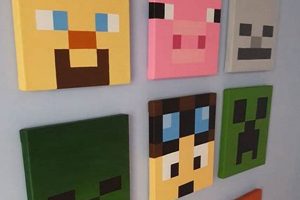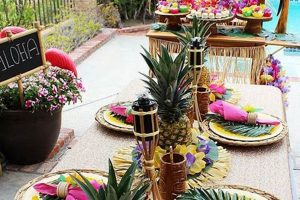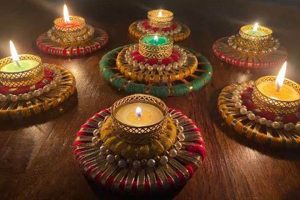The construction of oversized confectionery replicas for decorative purposes represents a burgeoning area within the crafting and event planning sectors. These large-scale simulations of sweets, typically fashioned from materials like foam, cardboard, or fabric, serve as visually striking enhancements for parties, holiday displays, and retail environments. An instance of this would be fabricating a five-foot-tall lollipop from painted foam board to adorn a birthday celebration.
Such oversized creations offer several advantages. They provide a cost-effective means of generating significant visual impact compared to purchasing professionally manufactured decorations. Furthermore, engaging in the fabrication process allows for customization to match specific color schemes or themes, enhancing the overall aesthetic coherence of an event. Historically, the use of crafted representations for decorative purposes has roots in various cultural traditions, evolving to encompass contemporary trends and materials.
The subsequent sections will delve into specific techniques for producing these decorations, including material selection, construction methodologies, and surface finishing options to ensure durability and visual appeal. Topics will range from simple techniques suitable for beginner crafters to more advanced methods for achieving professional-quality results.
Tips for Creating Oversized Confectionery Decorations
Achieving visually appealing and structurally sound results when constructing large-scale sweet simulations requires careful planning and execution. The following tips provide guidance on various aspects of the fabrication process.
Tip 1: Material Selection is Paramount: Choose materials appropriate for the intended environment. Expanded polystyrene foam offers lightweight volume, suitable for indoor displays. For outdoor use, consider weather-resistant options like closed-cell foam or treated wood.
Tip 2: Prioritize Structural Integrity: Large-scale representations necessitate internal support. Incorporate wooden dowels, PVC pipe, or cardboard tubes to reinforce the core, preventing warping or collapse, especially for taller or wider designs.
Tip 3: Accurate Scaling is Critical: Employ precise measurements and scale drawings before commencing construction. Ensure proportions remain consistent with the real-world counterparts to maintain visual fidelity. Inaccurate scaling can diminish the overall impact.
Tip 4: Employ Layered Construction Techniques: For complex shapes, build up layers of material gradually. This allows for greater control over contours and facilitates easier corrections. Adhere layers with appropriate adhesives, ensuring complete bonding.
Tip 5: Finishing Techniques Enhance Realism: Apply surface treatments mimicking the textures and sheens of actual sweets. Use glossy paints, varnishes, or textured coatings to achieve the desired effect. Consider adding details like sprinkles or wrappers for added authenticity.
Tip 6: Secure Mounting for Display: Plan for secure mounting hardware. Depending on the size and weight, use sturdy bases, hanging mechanisms, or support structures. Account for environmental factors such as wind or potential impact from passersby.
Tip 7: Consider Transportation and Storage: Evaluate the feasibility of transporting and storing the completed items. Modular designs can simplify logistics. Protect finished surfaces with appropriate coverings during handling and storage.
By adhering to these guidelines, the creation of impressive and durable decorations is within reach. These oversized simulations can elevate the aesthetic of any event or space, provided careful attention is paid to design, construction, and finishing.
The subsequent sections will offer detailed instructions and design considerations for creating specific types of oversized sweet simulations.
1. Scale and Proportion
Scale and proportion are foundational elements in the successful creation of oversized confectionery replicas. Accurate representation of these elements dictates the visual impact and believability of the finished product, influencing its effectiveness as a decorative piece.
- Maintaining Relative Dimensions
The principle of maintaining relative dimensions ensures that the various components of the faux confectionery item are sized appropriately in relation to one another. For example, in a giant lollipop, the diameter of the candy portion must be proportional to the length and width of the stick. Deviation from established proportions creates a distorted and unconvincing effect, undermining the overall visual appeal.
- Impact of Exaggerated Scale
While adhering to accurate proportions is crucial, strategic exaggeration of scale can be employed to enhance the visual impact of the decorations. Intentionally creating a substantially larger-than-life replica amplifies its attention-grabbing quality and contributes to a sense of whimsy or spectacle. However, such exaggeration must be carefully considered to avoid compromising the item’s recognizability or aesthetic coherence.
- Consideration of Viewing Distance
The intended viewing distance influences the perceived accuracy of scale and proportion. A decoration intended for close-up viewing requires a higher degree of precision in its dimensions. Conversely, a decoration viewed from a greater distance allows for more leniency in detailing and precision, as minor inaccuracies become less noticeable.
- Material Limitations and Practicality
Material limitations and practicality constrain the potential scale and proportions of the crafted sweets. Overly ambitious designs may prove structurally unsound or prohibitively difficult to construct given the available materials and skill level. A balance must be struck between the desired visual impact and the feasibility of creating a stable and manageable item.
By carefully considering the interplay between scale and proportion, and adapting the design to suit the viewing context and material constraints, effective oversized confectionery decorations can be produced. These decorations, when executed with attention to detail, will enhance the aesthetic of events or spaces.
2. Material Durability
The longevity and structural integrity of oversized confectionery replicas are directly contingent upon the selection of durable materials. This relationship is fundamental in the context of crafting these decorations, as materials lacking adequate resistance to environmental factors or physical stress compromise their intended purpose and aesthetic value. For instance, crafting a giant lollipop from untreated cardboard exposes it to rapid degradation under humid conditions, causing warping, structural weakening, and ultimately, a shortened lifespan. Therefore, material durability is not merely a desirable attribute but a necessary component for effective oversized sweet simulations.
Real-life examples underscore the practical significance of this understanding. Decorations intended for outdoor use necessitate weather-resistant materials such as closed-cell foam, treated wood, or durable plastics. These materials withstand exposure to moisture, ultraviolet radiation, and temperature fluctuations without significant deterioration. In contrast, indoor decorations may utilize less robust materials, such as expanded polystyrene, provided they are adequately protected from physical damage and moisture. The choice of paints and adhesives also plays a crucial role; selecting products designed for the chosen material ensures long-term adhesion and color retention. Properly adhering to durability considerations extends the usable life of these decorative items and prevents costly replacements.
In summation, material durability represents a cornerstone in the creation of oversized confectionery decorations. The successful fabrication of these items hinges on a thorough understanding of material properties and their suitability for the intended environment and application. Neglecting this critical aspect inevitably leads to premature failure and diminishes the overall value of the decorative investment. Addressing the challenge of material selection effectively ensures the enduring visual appeal and structural soundness of these creative enhancements.
3. Color Accuracy
Color accuracy plays a pivotal role in the creation of believable and visually appealing oversized confectionery replicas. The faithful reproduction of hues associated with specific sweets directly influences their recognizability and overall effectiveness as decorative elements. Inaccurate coloration can result in confusion, diminished aesthetic impact, and a perception of amateur craftsmanship. The degree to which colors match established standards or consumer expectations directly affects the viewer’s immediate interpretation and appreciation of the item.
Consider, for example, the reproduction of a recognizable chocolate brand’s wrapper. Slight deviations from the expected brown shade or the gold foil detailing immediately compromise the visual association and undermine the intended impact. Similarly, a giant gumball machine with inaccurately colored gumballs lacks the vibrancy and visual appeal inherent in the original. Achieving color fidelity necessitates careful selection of paints, dyes, or surface treatments that closely match the intended hues. This may involve color matching using specialized tools or techniques, referencing established color palettes, and considering the impact of lighting conditions on perceived color. Practical applications include meticulous mixing of paints to achieve precise shades, utilizing printed vinyl wraps for consistent color reproduction, and applying protective coatings to prevent fading or discoloration over time.
In conclusion, color accuracy constitutes a critical element in the fabrication of successful oversized confectionery decorations. It directly impacts the viewer’s recognition, appreciation, and overall perception of the finished product. Diligent attention to color matching, selection of appropriate materials, and application of suitable finishing techniques are essential for achieving visually compelling and believable replicas that enhance the aesthetic of events or spaces. Overcoming the challenges of color fidelity contributes significantly to the overall success and impact of these decorative items.
4. Structural Support
The implementation of structural support is paramount in the realm of DIY giant candy decorations, ensuring stability, longevity, and safety. Without adequate internal reinforcement, these large-scale creations are susceptible to collapse, deformation, and potential hazards, rendering them ineffective as decorative elements. The following details explore facets of structural support vital to their successful construction.
- Internal Framework Integration
The incorporation of an internal framework serves as the primary means of providing structural integrity. Materials such as wood, PVC pipe, or metal rods are often employed to create a skeletal structure that supports the outer shell of the confectionery replica. This framework distributes weight evenly and resists external forces, preventing warping or breakage. For instance, a giant lollipop may utilize a wooden dowel running through its center, anchored to a stable base, to maintain its upright position and prevent it from toppling over. The absence of such a framework typically results in structural failure, particularly in larger or more complex designs.
- Material Density and Load Distribution
Material density directly impacts the load-bearing capacity of the decoration. Denser materials, such as high-density foam or reinforced cardboard, offer greater resistance to compression and bending compared to less dense alternatives. Proper load distribution is also critical; concentrating weight in specific areas can lead to localized stress and eventual failure. Implementing internal supports to redistribute weight across the structure mitigates this risk. An example is a giant gumdrop, where internal bracing ensures the soft exterior material doesnt deform under its own weight.
- Joint Reinforcement Techniques
Joints, where different structural elements connect, represent points of vulnerability in the overall design. Reinforcement techniques, such as gluing, screwing, or welding, are necessary to ensure the secure attachment of these components. The specific method employed depends on the materials being joined and the anticipated stress on the connection. An illustration is the secure fastening of a lollipop stick to the candy portion, using epoxy or screws to prevent detachment under stress. Weak or poorly executed joints compromise the structural integrity of the entire decoration.
- External Bracing and Stabilization
In some instances, external bracing may be required to provide additional stability, particularly for decorations exposed to external forces like wind or pedestrian contact. This can involve the use of wires, ropes, or additional support structures to anchor the decoration and prevent it from tipping over. Consider a giant gingerbread man; supports on the back help to stabilize for better display on windows. Effective external bracing ensures the decoration remains upright and secure, minimizing the risk of damage or injury.
These components of structural support, when properly implemented, contribute to the creation of durable, stable, and safe DIY giant candy decorations. Overlooking these considerations compromises the longevity and overall effectiveness of these decorative items.
5. Surface Finish
Surface finish is integral to the creation of visually convincing DIY giant candy decorations, influencing their perceived realism, durability, and overall aesthetic appeal. The selected finish not only determines the appearance of the decoration but also provides a protective layer against environmental factors and physical wear, thereby extending its lifespan and maintaining its aesthetic qualities.
- Mimicking Textures and Sheens
The replication of authentic confectionery textures and sheens is paramount in achieving a realistic appearance. Glossy finishes, such as those obtained through the application of high-gloss paints or clear coats, emulate the polished surface of hard candies or glazed sweets. Conversely, matte finishes can simulate the texture of powdered candies or uncoated chocolates. The careful selection and application of appropriate finishing materials directly impact the believability of the oversized replica. For example, applying a textured coating to a giant gumdrop mimics the slightly rough surface of the real candy, enhancing its visual authenticity. Failure to accurately reproduce these surface characteristics can result in a flat and unconvincing representation.
- Protective Coating Application
Surface finishes provide a crucial protective barrier against environmental elements, preventing damage and degradation of the underlying materials. Clear coats, varnishes, and sealants shield the decoration from moisture, ultraviolet radiation, and physical abrasion, extending its lifespan and preserving its aesthetic qualities. Decorations intended for outdoor display require finishes specifically formulated for weather resistance. The absence of a protective coating leaves the underlying materials vulnerable to damage, leading to fading, cracking, and structural weakening. Consider a giant candy cane displayed outdoors; a UV-resistant clear coat prevents the colors from fading in sunlight and protects the surface from rain and snow.
- Color Enhancement and Preservation
The application of surface finishes can enhance the vibrancy and saturation of colors, contributing to a more visually appealing result. Clear coats can intensify the underlying colors, creating a more striking and realistic effect. Furthermore, certain finishes incorporate UV inhibitors that protect colors from fading over time, ensuring that the decoration retains its aesthetic qualities for an extended period. A faded or discolored surface finish detracts from the overall impact of the decoration, rendering it less visually appealing. Applying a color-enhancing sealant to a giant cupcake can make the “frosting” appear more vibrant and appetizing.
- Seamless Integration and Blending
Surface finishes facilitate the seamless integration and blending of different materials and components used in the construction of the decoration. Fillers, sealants, and smoothing compounds can be used to conceal seams, gaps, and imperfections, creating a more cohesive and polished appearance. The application of a uniform surface finish over the entire decoration unifies the various elements, creating a visually harmonious result. Uneven surfaces or visible seams detract from the overall quality of the decoration. Using a smoothing compound to blend the edges of different foam pieces in a giant donut, followed by a uniform paint finish, creates a seamless and professional-looking result.
The strategic application of surface finishes elevates DIY giant candy decorations from rudimentary constructions to visually compelling and durable decorative elements. The thoughtful selection and skillful application of appropriate finishing materials are essential for achieving a realistic, long-lasting, and aesthetically pleasing result.
6. Transportation Logistics
The feasibility of creating and utilizing DIY giant candy decorations is intrinsically linked to transportation logistics. The often substantial size and delicate nature of these creations necessitate careful planning and execution of their movement from the point of fabrication to their intended display location. Inadequate consideration of transportation logistics can result in damage, increased costs, and ultimately, the unrealized potential of the decorative items. For instance, a meticulously crafted six-foot-tall candy cane, if improperly packaged or transported, could suffer structural damage rendering it unusable. Therefore, effective transportation logistics represents a critical component of the overall project, influencing both its success and its cost-effectiveness.
Practical applications of this understanding include several key considerations. Firstly, pre-construction planning must incorporate an assessment of transportation constraints, influencing design choices and material selection. Modular designs, which allow for disassembly and reassembly at the destination, can significantly ease transportation challenges. Secondly, appropriate packaging materials, such as custom-fitted crates, protective foam padding, and secure strapping, are essential for safeguarding the decorations during transit. Thirdly, selection of a suitable transportation method, whether it be a personal vehicle, a commercial moving service, or specialized art transportation, must align with the size, weight, and fragility of the items. Finally, route planning should account for potential obstacles, such as narrow doorways, staircases, or uneven terrain, which may require specialized equipment or handling techniques. Consider the example of transporting a collection of oversized lollipops to a children’s hospital; this requires consideration of accessibility within the hospital and patient safety.
In summation, transportation logistics represents a non-negligible factor in the successful execution of DIY giant candy decoration projects. The effective management of this aspect minimizes the risk of damage, reduces logistical complexities, and ensures the timely and cost-effective delivery of these decorative elements to their intended locations. Addressing the challenges of transportation proactively contributes to the overall success and visual impact of the project, thereby maximizing its potential as a decorative enhancement. Therefore, adequate planning, preparation, and execution of transportation logistics are indispensable for realizing the full benefits of these oversized creations.
Frequently Asked Questions About DIY Giant Candy Decorations
The subsequent questions address common inquiries and concerns regarding the creation and utilization of oversized confectionery replicas as decorative elements. They aim to provide clarity and guidance for those undertaking such projects.
Question 1: What are the most suitable materials for creating weather-resistant, large-scale candy decorations for outdoor use?
Materials such as closed-cell foam, treated wood, and durable plastics offer superior resistance to moisture, ultraviolet radiation, and temperature fluctuations, making them appropriate choices for outdoor applications.
Question 2: How can structural integrity be ensured when constructing oversized candy decorations, particularly for taller or wider designs?
Implementing an internal support framework using materials like wooden dowels, PVC pipe, or metal rods provides essential reinforcement, preventing warping, bending, or collapse. Securely anchoring the framework to a stable base is also crucial.
Question 3: What techniques are most effective for achieving accurate color representation when painting or finishing giant candy decorations?
Color matching using specialized tools or referencing established color palettes ensures fidelity to intended hues. Employing high-quality paints designed for the chosen material and applying protective coatings to prevent fading or discoloration are also recommended.
Question 4: What considerations are paramount when transporting large and potentially fragile candy decorations to prevent damage?
Utilizing custom-fitted crates, protective foam padding, and secure strapping safeguards decorations during transit. Selecting a suitable transportation method, whether a personal vehicle or a specialized art transport service, is essential. Careful route planning to avoid obstacles also minimizes risk.
Question 5: How can a glossy, candy-like surface finish be effectively achieved on DIY decorations?
The application of high-gloss paints, clear coats, or epoxy resins creates a polished, reflective surface mimicking hard candies or glazed sweets. Multiple thin coats are generally preferable to a single thick coat to prevent runs or drips.
Question 6: What are the best practices for storing oversized candy decorations to prevent damage or degradation when not in use?
Storing decorations in a dry, climate-controlled environment protects them from moisture, temperature extremes, and ultraviolet radiation. Wrapping them in protective coverings, such as bubble wrap or fabric sheets, prevents scratches and abrasions.
The insights presented in these FAQs should assist in navigating the complexities of creating durable, visually appealing, and practically manageable DIY giant candy decorations.
The subsequent section will focus on specific design considerations and step-by-step instructions for crafting particular types of oversized sweet simulations.
Conclusion
The preceding exploration of “diy giant candy decorations” elucidates the critical factors influencing their successful creation and deployment. Material selection, structural integrity, color accuracy, surface finishing, and transportation logistics represent essential considerations that determine the longevity, visual impact, and practical feasibility of these decorative elements. Thorough attention to these aspects enables the creation of impressive and cost-effective additions to events, displays, and environments.
The value of carefully planned and executed construction, appropriate materials, and suitable design is clear for those pursuing such projects. By carefully reviewing available resources and prioritizing detail, the creation of stunning and long-lasting decorative results is possible. As visual marketing and personalized event design evolve, well-executed “diy giant candy decorations” will continue to offer versatile opportunities for creative expression and aesthetic enhancement.







